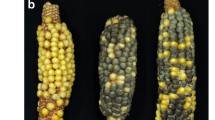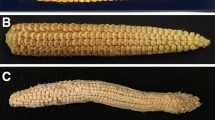Abstract
Many popcorn strains cannot be fertilized by pollen of dent and flint strains although the reciprocal crosses are successful. Similarly, plants of some annual teosinte populations can fertilize maize but do not accept its pollen. Single genes or gene complexes govern these two unilateral barriers to crossing. Failure of fertilization could reflect active rejection by the pistil of pollen containing a contrasting allele (incompatibility). Alternatively, the pistil could require presence of a matching allele in pollen (congruity). To distinguish between these possibilities genetically, the receptivity to pollen having both alleles was determined. If there is active rejection, heteroallelic pollen would not be accepted; if presence of a matching allele is required, heteroallelic pollen would be accepted. In both the popcorn and teosinte crossing barrier systems, heteroallelic pollen functioned, consistent with the congruity model.



Similar content being viewed by others
References
Asher PD, Peloquin SJ (1968) Pollen tube growth and incompatibility following intra- and inter-specific pollinations in Lilium longiflorum. Am J Bot 55:1230–1234
Auger DL, Birchler JA (2002) Maize tertiary trisomic stocks derived from B-A translocations. J Heredity 93:42–47
Beckett JB (1983) Kernel-weight effects and transmission of a partial trisome involving the long arm of chromosome 5 in maize. Can J Genet Cytol 25:346–353
Beckett JB (1991) Cytogenetic, genetic and plant breeding applications of B-A translocations in maize. In: Gupta PK, Tsuchiya T (eds) Chromosome engineering in plants: genetics, breeding, evolution, vol 2A. Elsevier, Amsterdam, pp 493–529
Bernacchi D, Tanksley SD (1997) An interspecific backcross of Lycopersion esculentum × L. hirsutum: linkage analysis and a QTL study of sexual compatibility factors and floral traits. Genetics 147:861–877
Birchler JA (1993) Trisomic manipulation. In: Freeling M, Walbot V (eds) The maize handbook. Springer, Berlin Heidelberg New York, pp 302–308
de Nettancourt D (2001) Incompatibility and incongruity in wild and cultivated plants. 2nd edn. Springer, Berlin Heidelberg New York
Edlund AF, Swanson R, Preuss D (2004) Pollen and stigma structure and function: the role of diversity in pollination. Plant Cell 16:S84–S97
Emerson RA (1934) Relation of the differential fertilization genes, Ga ga, to certain other genes of the Su-Tu lineage group of maize. Genetics 19:137–156
Evans MMS, Kermicle JL (2001) Teosinte crossing barrier 1, a locus governing hybridization of teosinte with maize. Theor Appl Genet 103:259–265
Franklin-Tong VE, Franklin FCH (2003) The different mechanisms of gametophytic self-incompatibility. Phil Trans R Soc Lond Ser B 358:1025–1032
Grun P, Aubertin M (1966) The inheritance and expression of unilateral incompatibility in Solanum. Heredity 21:131–138
Hancock CN, Kondo K, Beecher B, McClure B (2003) The S-locus and unilateral incompatibility. Phil Trans R Soc Lond Ser B 358:1133–1140
Hermsen JGTh, Olsder J, Jansen P, Hoving E (1974) Acceptance of self-compatible pollen from Solanum verrocosum in dihaploids from S. tuberosum. In: Linskens HF (ed) Fertilization in higher plants. North Holland, Amsterdam, pp 37–40
Hogenboom NG (1972) Breaking breeding barriers in Lycopersicon. 5. The inheritance of the unilateral incompatibility between L. peruvianum (L.) Mill. and L. esculentum Mill. and the genetics of its breakdown. Euphytica 21:405–414
Hogenboom NG (1975) Incompatibility and incongruity: two different mechanisms for the non-functioning of intimate partner relationships. Proc R Soc Lon B 188:361–375
Hogenboom NG (1984) Incongruity: non-functioning of intercellular and intracellular partner relationships through non-matching information. In: Linskens HF, Heslop-Harrison J (eds) Encyclopedia of plant physiology. Springer, Berlin Heidelberg New York, pp 640–654
Jones DF (1920) Selective fertilization in pollen mixtures. Biol Bulletin 38:251–289
Kao T-h, Tsukamoto T (2004) The molecular and genetic basis of S-RNase-based self-incompatibility. Plant Cell 16:S72–S83
Kachroo A, Nasrallah ME, Nasrallah JB (2002) Self-incompatibility in the Brassicaceae: receptor-ligand signaling and cell-to-cell communication. Plant Cell 14:5227–5238
Kermicle JL (2001) Genetic barriers that restrict hybridization in corn and teosinte. Corn Sorghum Res Conf 56:17–23
Kermicle JL, Allen JO (1990) Cross incompatibility between maize and teosinte. Maydica 35:399–408
Lee EA, Darrah LL, Coe EH (1996) Dosage effects on morphological and quantitative traits in maize aneuploids. Genome 39:898–908
Lewis D, Crowe LK (1958) Unilateral incompatibility in flowering plants. Heredity 12:233–256
Liedl BE, McCormick S, Mutschler MA (1996) Unilateral incongruity in crosses involving Lycopersicon penellii and L. esculentum is distinct from self-incompatibility in expression, timing and location. Sex Plant Reprod 9:299–308
Meyer P, Saedler H (1996) Homology-dependent gene silencing in plants. Annu Rev Plant Phys 47:23–48
Murfett J, Strabala TJ, Zurek DM, Mou B, Beecher B, McClure BA (1996) S RNase and interspecific pollen rejection in the genus Nicotiana: multiple pollen-rejection pathways contribute to unilateral incompatibility between self-incompatible and self-compatible species. Plant Cell 8:943–958
Nelson OE (1952) Non-reciprocal cross-sterility in maize. Genetics 36:101–124
Nelson OE (1993) The gametophyte factors of maize. In: Freeling M, Walbot V (eds) The maize handbook. Springer, Berlin Heidelberg New York pp 496–503
Roman H (1947) Mitotic nondisjunction in the case of interchanges involving the B-type chromosome in maize. Genetics 32:391–409
Sanchez AM, Bosch M, Bots M, Nieuwland J, Feron R, Mariani C (2004) Pistil factors controlling pollination. Plant Cell 16:S98–S106
Stone SL, Anderson EM, Mulen RT, Goring DR (2003) ARC1 is an E3 ubiquitin ligase and promotes the ubiquination of proteins during the rejection of self-incompatible Brassica pollen. Plant Cell 15:885–898
Swanson R, Edlund AF, Preuss D (2004) Species specificity in pollen–pistil interactions. Annu Rev Genetics 38:739–818
Acknowledgements
We thank Millard Susman for suggestions concerning the manuscript. Research supported by USDA NRI award 35301–13314.
Author information
Authors and Affiliations
Corresponding author
Rights and permissions
About this article
Cite this article
Kermicle, J.L., Evans, M.M. Pollen–pistil barriers to crossing in maize and teosinte result from incongruity rather than active rejection. Sex Plant Reprod 18, 187–194 (2005). https://doi.org/10.1007/s00497-005-0012-2
Received:
Revised:
Accepted:
Published:
Issue Date:
DOI: https://doi.org/10.1007/s00497-005-0012-2




